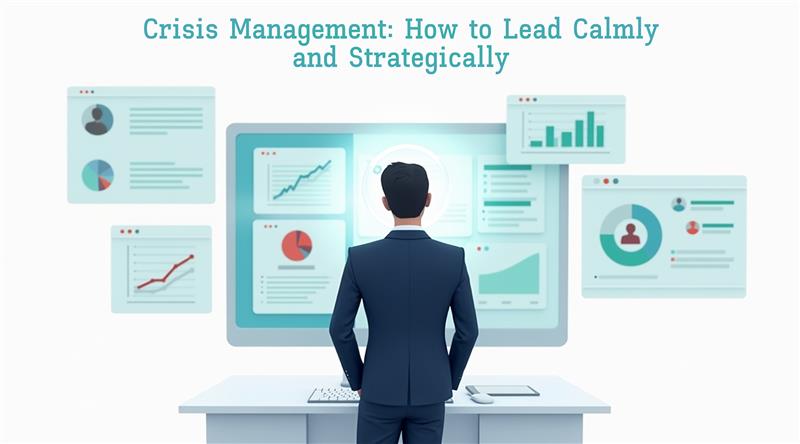Crises don’t send calendar invites. They hit fast, often when you’re least prepared and how you respond can either protect your reputation or damage it for years. Whether you’re a business leader, communications professional, or simply navigating a high-stakes moment, mastering crisis management is non-negotiable.
In this article, you’ll learn practical, expert strategies for managing crises effectively, protecting trust, and leading with clarity under pressure.
What Is Crisis Management and Why It’s More Than Just PR
Crisis management is the process of preparing for, responding to, and recovering from disruptive events that threaten your organisation’s people, reputation, operations, or finances.
It’s not just about crafting a slick public statement. Real crisis management is cross-functional blending communication, decision-making, legal compliance, and leadership under pressure. It requires more than good instincts. It demands systems, planning, and clear thinking.
Whether it’s a cybersecurity breach, a public scandal, a natural disaster, or a product recall, your response must be swift, honest, and aligned across every channel.
The Anatomy of an Effective Crisis Response
1. Preparation: Crisis Management Starts Before the Crisis
The most effective crisis management begins long before anything goes wrong. Start with a robust, regularly updated crisis plan that includes:
- A crisis response team with defined roles
- Pre-drafted statements tailored for different platforms
- Scenario plans for likely and high-impact threats
- Real-time communication channels like Slack or Teams for internal coordination
Run drills. Update your plan annually. The goal is to avoid scrambling when stakes are highest.
2. Detection: Spot Weak Signals Before They Become Alarms
Crises rarely erupt out of nowhere. Often, they’re preceded by warning signs customer complaints, system anomalies, disgruntled employees. Build internal systems to flag these early.
Encourage employees to report issues without fear. Track your brand online. Monitor operations closely. Early detection can buy precious time and mitigate fallout.
3. Initial Response: Speed, Clarity and Control
In the first few hours, your message sets the tone. Here’s what matters most:
- Acknowledge the situation publicly and internally, even if details are limited.
- Be human use empathetic language, especially if harm is involved.
- Avoid speculation stick to verified facts only.
- Centralize communication ideally through a designated spokesperson or team.
Silence or confusion in this window can do irreversible damage.
Communication During a Crisis: What to Say (and What to Avoid)
Messaging is where many organizations trip up. During a crisis, people want transparency, accountability, and reassurance.
What to do:
- Take responsibility if your organization is at fault.
- Explain what you’re doing next not just what happened.
- Provide updates regularly, even if they’re brief.
What to avoid:
- Blaming others too early.
- “No comment” responses they fuel mistrust.
- Over-promising or stating things you can’t back up.
Your tone should balance empathy with authority. You’re not just sharing facts you’re showing leadership.
Recovery and Reputation Repair
Once the immediate threat has passed, the work isn’t over. True crisis management includes post-crisis recovery:
- Conduct a post-mortem to assess what went wrong and how your team responded.
- Follow up with affected customers or stakeholders personally if needed.
- Rebuild trust through continued transparency, meaningful change and consistent communication.
Reputations aren’t restored overnight. But with a thoughtful recovery plan, you can come back stronger and more credible than before.
Crisis Management in the Digital Age
Social media has changed the crisis management game. News spreads fast, and misinformation spreads faster. In this landscape:
- Respond in minutes, not hours.
- Monitor your brand in real time using listening tools.
- Engage directly with concerned audiences rather than hiding behind corporate statements.
Speed doesn’t mean sloppiness but waiting too long to engage often looks like avoidance or denial.
The Bottom Line
Crisis management isn’t about perfection it’s about preparation, leadership, and response under pressure. If you have a solid plan, a trained team, and a clear sense of your values, you’re already ahead of the curve.
Because in a crisis, people won’t remember how smooth things were before. They’ll remember how you handled the moment when it mattered most.
In times of crisis, maintaining composure and applying strategic thinking are not just leadership qualities they’re essential research competencies too. As a PhD scholar, you may often encounter academic pressures that feel like crises themselves, from tight deadlines to complex methodologies. If you’re navigating the challenging phases of your doctoral journey and need guidance, consider professional Thesis Writing support or a dedicated Research Assistant to streamline your progress.
Frequently Asked Questions (FAQs)
Q1: What is the first step in crisis management?
The first step is preparation. Build a detailed crisis response plan, designate roles, and rehearse scenarios so your team can move quickly and calmly when a crisis hits.
Q2: How do you communicate effectively during a crisis?
Stick to facts, be transparent, show empathy, and update regularly. Appoint a clear spokesperson and tailor your message for each audience.
Q3: How soon should I respond in a crisis?
Ideally, within the first hour. Even if you don’t have all the facts, acknowledging the situation and committing to updates shows control and accountability.
Q4: What’s the most common mistake companies make during crises?
Silence or deflection. Avoiding responsibility or failing to communicate clearly often causes more reputational damage than the crisis itself.
Q5: How can I rebuild trust after a crisis?
Own your mistakes, show the steps you’re taking to improve, and follow through on your promises. Consistency over time is key to restoring credibility.





Comments